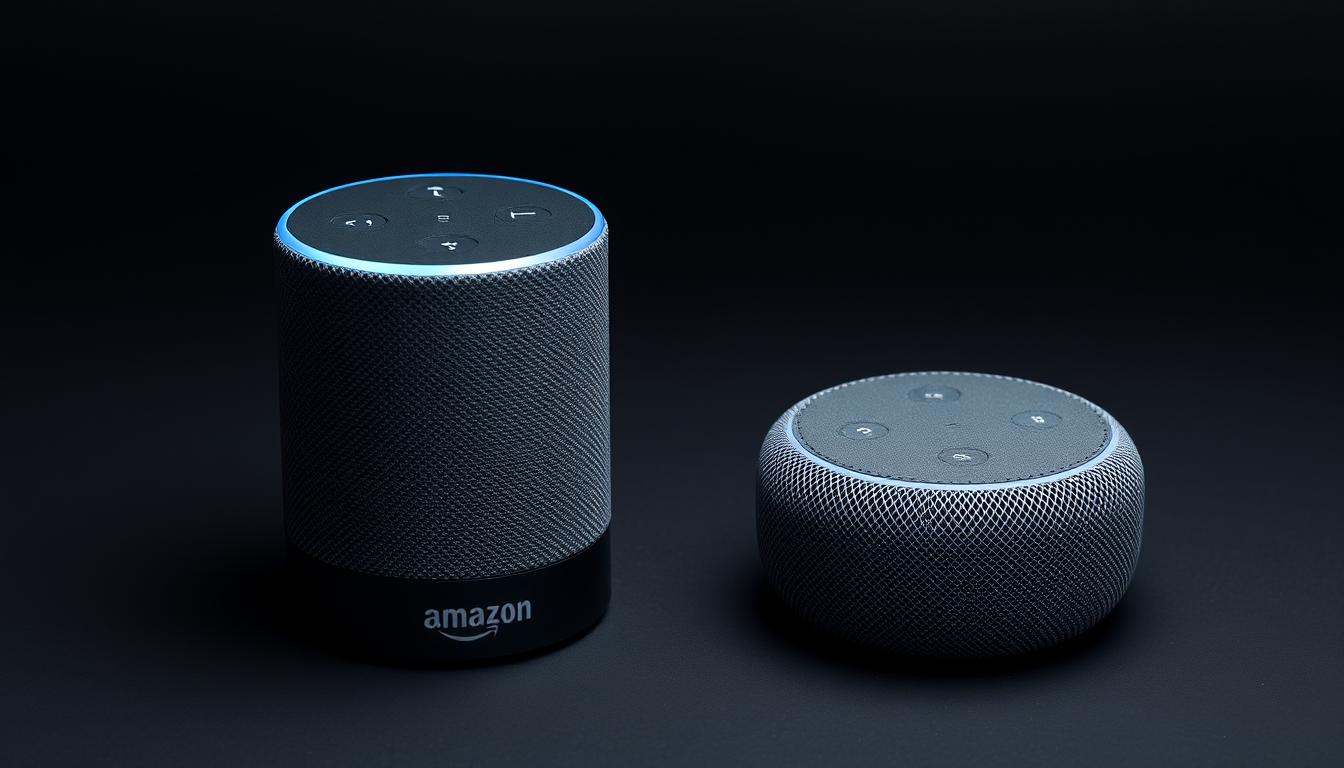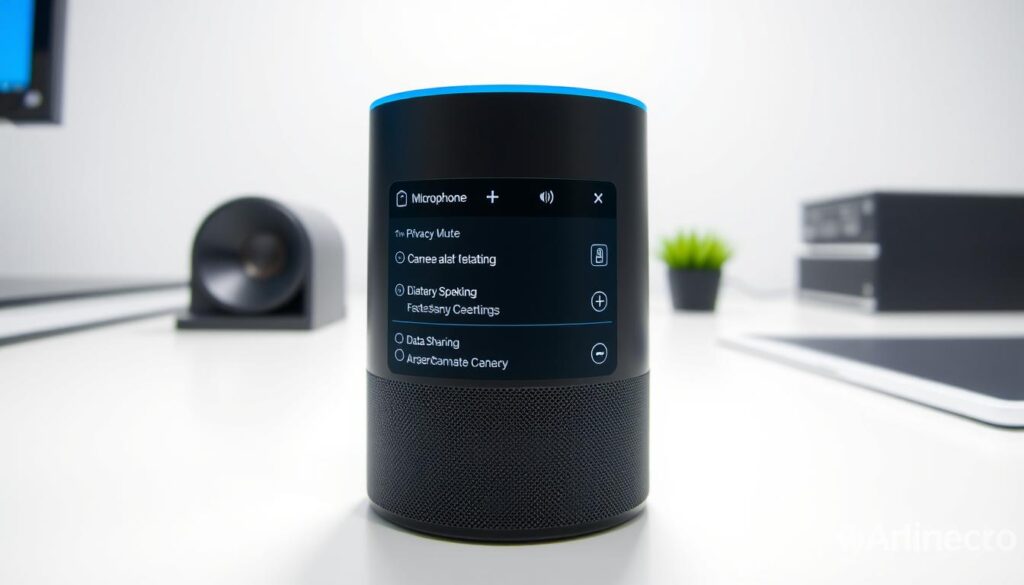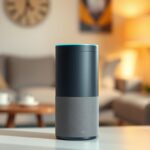How much better is the Echo vs Echo Dot?

This short guide helps U.S. shoppers pick the right smart speaker for each room. It compares sound, intelligence, price, and placement so readers match a model to their budget and space. The amazon echo family spans compact choices and larger units for richer audio.
Readers will learn what hands-free information the devices can deliver, which features improve with Alexa+ on newer models, and how many devices support things like mesh network extension for home coverage.
The guide also outlines design choices that affect where a speaker fits on a nightstand or counter. It previews which amazon echo dot and larger speakers justify an upgrade based on sound, mic response, smart home control, and reviews.
At a glance: Which smart speaker is better for a U.S. home today?
This snapshot sorts current models by price, audio, and smart features so buyers match a speaker to a room and budget.
Value picks for small rooms: Echo Dot and Echo Dot Max give strong performance at modest prices. Echo Dot Max debuts at $99.99 with AZ3 processing and dual speakers for clearer conversation detection.
Budget option: Echo Pop stays the $39.99 entry point and suits renters or tiny apartments that need basic voice help without extra setup.
- Big-room audio: amazon echo Studio ($219.99) targets immersive sound with spatial audio and Dolby Atmos.
- Smart displays: Echo Show 8 and 11 bring Alexa+ Early Access, built-in hubs (Zigbee, Matter, Thread), and proactive Omnisense features.
- Price tiers: Pop $39.99, Dot $49.99, Dot Max $99.99, Show 8 $179.99, Show 11 $219.99, Studio $219.99.
For most U.S. homes, choose compact speakers for bedrooms and kitchens, mid‑priced units for balanced sound and smarter interactions, and Studio or Show models where bass, display, or home-hub support matter most.
Specs snapshot and model lineup for Amazon Echo and Amazon Echo Dot
This quick specs snapshot helps readers match each speaker to a room and budget.
Current versions center on new silicon and stronger audio. The Echo Dot Max launches at $99.99 with an AZ3 chip and a two‑way speaker system (woofer + tweeter). It claims nearly three times the bass of the 5th‑gen amazon echo dot.
Year‑over‑year changes
Recent versions moved to AZ3 and AZ3 Pro silicon for better on‑device wake detection and faster processing. Echo Show 8 and Echo Show 11 add AZ3 Pro, Omnisense, and built‑in hubs for Zigbee, Matter, and Thread support.
Where Dot Max fits vs classic models
The amazon echo roster ranges from the $39.99 Echo Pop (AZ2) to the $219.99 Echo Studio with spatial audio and Dolby Atmos. Dot Max sits between the compact Dot and Studio, making it a solid choice for small living rooms or kitchens that need fuller sound without a bulky speaker.
| Model | Price | Chip | Best use |
|---|---|---|---|
| Echo Pop | $39.99 | AZ2 | Bedrooms, small apartments |
| Echo Dot (5th) | $49.99 | Standard AZ3 | Nightstands, desks |
| Echo Dot Max | $99.99 | AZ3 | Small living rooms, kitchens |
| Echo Studio | $219.99 | AZ3/Pro | Room‑filling audio, TV bundles |
Design and build: Orb vs orb, size, materials, and display options
Size, materials, and screen options determine where a device feels natural in a living space.
Form factors shape placement. The amazon echo family leans into sphere-first styling with fabric finishes that blend into shelves or nightstands. The echo dot range keeps a compact footprint; the Dot Max adds a two-way system inside a similarly small shell for fuller bass.
Echo Pop uses an angled, front-firing face with AZ2 silicon; it can also extend Eero Wi‑Fi. The 2024 Echo Spot returns as a compact orb with a simple display for bedside glanceable info. Display-forward units like echo show 8 and Echo Show 11 use in-cell touch displays, wider viewing angles, AZ3 Pro, plus built-in hubs for smart home control.
Quick comparison of forms
| Model | Shape | Best placement | Material |
|---|---|---|---|
| Echo Pop | Angled front | Desk, nightstand | Acoustic fabric |
| Echo Dot (standard) | Spherical | Nightstand, shelf | Textured fabric |
| Echo Dot Max | Spherical, larger internals | Small living room, kitchen | Fabric with larger cavity |
| Echo Show 8/11 | Floating screen | Counter, eye level | Mixed glass and fabric |
- Smaller footprints suit clutter-free rooms; display models prefer eye height.
- Improved mounts, cable routing, grip pads make placement stable on slick surfaces.
Sound quality and speakers: Room-filling audio vs compact convenience
Room size and placement change how much low end and clarity a smart speaker delivers.
Drivers and design matter most. The Echo Dot Max uses a two-way system with a woofer and tweeter and claims nearly three times the bass of the Echo Dot (5th gen). That makes it a clear upgrade for kitchens or small living rooms where a compact speaker must do heavy lifting.
The amazon echo Studio stays the top choice for immersive playback. It adds spatial audio and Dolby Atmos in a redesigned spherical shell at $219.99. Larger enclosures let the Studio hit deeper bass and higher volume without compression.
Home theater and playback
With Alexa Home Theater, users can pair up to five Echo Studio or Echo Dot Max units with compatible Fire TV for surround-like TV sound. Multiroom and Bluetooth support let devices stream from Amazon Music, Apple Music, Spotify, Deezer, Pandora, and SiriusXM.
- Best for music: Studio for fidelity and Atmos mixes.
- Best compact option: Dot Max for stronger bass in a small footprint.
- Everyday listening: Standard dot handles podcasts, audiobooks, and background radio.
| Model | Key speaker elements | Best use |
|---|---|---|
| Echo Studio | Woofer + multi drivers, Dolby Atmos | Room-filling music, TV with spatial audio |
| Echo Dot Max | Two-way (woofer + tweeter), boosted bass | Small living rooms, kitchens |
| Standard Echo Dot | Compact full-range driver | Bedrooms, desks, voice-first rooms |
Microphones, chips, and AI: How Alexa+ changes the experience
Modern smart speakers now combine custom AI chips with multiple sensors to anticipate needs and react faster.
New silicon boosts responsiveness. The AZ3 in the Echo Dot Max and AZ3 Pro in higher-tier models cut wake delays and improve on-device handling. That change raises day-to-day performance, especially in noisy kitchens or family rooms.
AZ3 vs AZ3 Pro
AZ3 Pro adds an AI accelerator for future on-device models. It supports faster conversation detection and better wake-word resilience than prior chips.
Omnisense and proactive sensing
Omnisense fuses camera input (on displays), audio, ultrasound, Wi‑Fi radar, accelerometer, and Wi‑Fi CSI. The result is smarter, proactive routines like starting a welcome routine when someone approaches or sending a night alert if a door stays open.
- Microphone arrays use model-based noise filtering so commands register over TV or vent noise.
- Alexa+ Early Access brings more natural multi-turn interactions and smoother orchestration of alexa skills and services.
- Edge plus cloud balance keeps responses quick while enabling regular improvements without user intervention.
Overall, the new tech makes the assistant feel more human and coordinated across amazon echo and echo dot models. Users should notice faster responses, smarter routines, and fewer repeats when issuing commands to their devices.
Smart home control: Built‑in hub, protocols, and device groups
A single hub-capable speaker can cut days off smart home setup and reduce compatibility headaches.
The Echo Show 8 and Echo Show 11 include built‑in Zigbee, Matter, and Thread. That support often removes the need for separate bridges when adding bulbs, sensors, or locks.
Group and routine setup is simpler on hub models. Users can make room groups for multiroom audio or bulk device control. Routines run on schedules, sensor triggers, or presence cues and gain extra context with Omnisense on supported units.
Zigbee, Matter, and Thread support
Built‑in protocol support means faster onboarding and fewer compatibility steps. Echo (4th gen) added a hub into an audio-first device, and current shows extend that capability for a wider set of devices.
Routines, Guard features, and ambient controls
Alexa Guard listens for smoke/CO alarms and glass breaking and sends alerts to the app. The Guard Plus subscription adds proactive deterrents such as recorded barking or sirens.
| Feature | Included on Show 8/11 | Benefit |
|---|---|---|
| Protocol support | Zigbee, Matter, Thread | Faster device onboarding; fewer bridges |
| Groups | Yes | Multiroom audio and room-based controls |
| Routines | Yes (Omnisense enhanced) | Automate lights, scenes, presence actions |
| Guard | Yes (app alerts) | Detects alarms, glass break; Guard Plus adds deterrents |
For most homes, starting with a hub-capable show device speeds setup and reduces troubleshooting with bulbs, switches, and sensors. Security-conscious users can mute microphones while continuing to control the system from the screen or app.
Connectivity and network: Wi‑Fi, Bluetooth, and Eero mesh extender perks
Good placement and network planning let compact speakers add real Wi‑Fi range where homes need it most.
Many amazon echo devices use Wi‑Fi for cloud services and Bluetooth for direct audio. That combination keeps voice control and streaming working across rooms.
Echo Dot and Echo Pop can function as Eero mesh extenders, adding up to 1,000 sq. ft. of coverage on compatible networks. This option helps when a router leaves dead zones in bedrooms or offices.
Practical connectivity notes
- Pairing a phone via Bluetooth gives quick playback from any app while maintaining voice controls.
- Echo Show models add visual access to camera feeds and media controls over the same Wi‑Fi link.
- Echo Auto brings in‑car voice features by bridging through a phone for navigation, calls, and music.
For households using Eero, placing compact units in trouble spots is a budget‑friendly way to extend coverage and keep devices responsive where people spend the most time.
Privacy, security, and controls
Built-in mute switches and visible camera shutters let users block microphones or cover lenses quickly. This gives clear, physical ways to protect personal information.

Voice history review will let users delete recordings and adjust skill permissions from the app. Household profiles will keep music, calendars, and lists separate for each person.
Alexa Guard listens for smoke and glass break when set to Away and will send app alerts. An optional Guard Plus plan adds deterrence sounds like a barking clip for modest added protection.
- Manual controls: PINs for purchases, disable Drop In, and limit calling to approved contacts.
- Visual cues: Light rings or on-screen notices show when a device is listening or calling.
- Updates: Software patches install automatically during off-hours to improve security and features.
For sensitive areas, owners may choose audio-only models with the mic muted until needed. Periodic audits of settings will keep devices aligned with personal privacy goals when using amazon echo or echo dot models.
Use cases by room: Bedroom, kitchen, living room, office, and kids’ rooms
Practical advice helps readers pick which smart speaker belongs in each room. Compact models suit small spaces while larger units serve shared areas. Placement choices affect alarms, timers, music, and hands-free questions around the home.
Alarms, timers, weather, and hands-free questions
Bedrooms benefit from a compact echo dot or the 2024 Echo Spot as a bedside clock. Devices offer gentle alarms, quick weather checks, and short questions without reaching for a phone.
Kitchens use timers, conversion help, and recipe steps with hands-free voice control while music or podcasts play from small speakers that save counter space.
Kids Editions, subscriptions, and parental safeguards
Kids’ rooms work well with Echo Dot Kids or Echo Show 5 Kids. Each includes a one-year Amazon Kids+ trial (then $5.99/month) with audiobooks, games, and age-appropriate skills plus a two-year worry-free guarantee.
Parents can set time limits, restrict calling to approved contacts, and manage content from the app. These safeguards keep families in control while children enjoy curated content.
| Room | Recommended model | Top use |
|---|---|---|
| Bedroom | Echo Spot (2024) or echo dot | Alarms, weather, quick questions |
| Kitchen | echo dot or Dot Max | Timers, recipes, music |
| Living room | amazon echo Studio or Dot Max | Better audio, TV pairing, family calendar |
| Home office | Compact echo models | Reminders, timers, drop-in intercom |
| Kids’ room | Echo Dot Kids, echo show 5 | Kids+, parental controls, games |
Price and value: What you get at $39-$219 and beyond
Shoppers will find clear tiers from ultra‑affordable starters to audio‑first flagship models.
Launch pricing sets expectations: Echo Pop $39.99, Echo Dot $49.99, Echo Dot Kids $59.99 (includes one year of Amazon Kids+; then $5.99/month), Echo Dot Max $99.99, Echo Show 8 $179.99, Echo Show 11 $219.99, Echo Studio $219.99. Echo Hub lists at $179.99 and the Echo Spot at $79.99.
The cost reflects hardware and features. Entry models cover basic hands‑free help and smart home control. Mid‑tier devices add better speakers and faster silicon. Premium units deliver room‑filling audio or built‑in hubs for a futureproof smart home.
How to think about value
- Audio vs. price: For one main room, the Dot Max often hits the sweet spot. For open plans, a Studio is worth the extra outlay.
- Subscription math: Kids editions include one year; plan for the monthly fee after the trial ends.
- Future proofing: Higher versions with built‑in hubs can cut accessory costs later.
| Tier | Best for | Notes |
|---|---|---|
| Entry | Bedrooms, small rooms | Lowest price, basic speakers |
| Mid | Kitchens, living rooms | Stronger bass, better chips |
| Premium | Large rooms, home hub | Spatial audio, display or hub |
Model history and evolution: From the first Echo to today’s lineup
Amazon’s voice speaker story began in 2014 with an invite-only launch that introduced hands-free music, weather, and timers. The product expanded widely in 2015 and then grew into a family of choices for different rooms.
In 2016 the echo dot puck arrived as an affordable, compact option suited for bedrooms and as a satellite for larger setups. Early versions improved recognition and made it easy to add multiple units across a single home.
By 2020 designs shifted to spherical shapes and added built-in hubs like Zigbee and Sidewalk. Shows with screens joined the lineup to enable video calls and visual controls.
Why the small speaker became the bestseller for tiny rooms
Affordability and flexible placement made the small unit the everyday choice. Users could buy several for consistent voice access without heavy cost.
Recent years added custom silicon (AZ3 and AZ3 Pro) for faster on-device handling and more natural routines. The platform now spans ultra-compact Pop to premium Studio, plus displays, Auto, Frames, and Hub products.
| Year | Key model | Impact |
|---|---|---|
| 2014 | First amazon echo | Started in‑home voice use |
| 2016 | echo dot | Low cost, room coverage |
| 2020 | Spherical versions | Hubs, improved design |
echo dot and alexa compatibility: Skills, services, and ecosystem support
Compatibility with third‑party services turns a compact speaker into a multitool for home tasks.
“The broader the service catalog, the more a device fits daily life.”
The amazon echo family links to major music services like Amazon Music, Apple Music, Spotify, Pandora, and SiriusXM. Bluetooth input adds access to apps that lack native support. That makes streaming and podcasts simple across rooms.
Third‑party skills and media
The Alexa Skills Kit lets developers publish third‑party skills for errands, rideshare bookings, and productivity tools. Users gain quick access to services from brands and can enable new features without new hardware.
Calling, video, and casual games
Audio-only devices handle calling and messaging to approved contacts. The echo show adds video calling and Drop In for intercom‑style chats. Casual trivia and family games run well on both types of devices, keeping living rooms engaged.
- Alexa+ store: A forthcoming store will surface services like TaskRabbit and rideshare partners for easy discovery and subscription management.
- Multi‑device sync: Content, skills, and access follow accounts from room to room for seamless use.
| Feature | Benefit | Best for |
|---|---|---|
| Streaming services | Broad music and podcast access | Every home |
| Third‑party skills | New tasks via voice | Productivity & errands |
| Video calls | Face‑to‑face chat | Show‑equipped rooms |
Buying guide: Choosing the right speaker or display for your setup
A clear checklist helps shoppers match hardware to habits, room size, and future plans.
Start with use. Choose audio‑first if music and movies matter, display‑first for glanceable controls and video, or a budget entry if price is the main concern.
Audio‑first vs display‑first vs budget
For compact power, the echo dot Max adds dual drivers and stronger bass at $99.99. For premium fidelity, the Echo Studio supports Dolby Atmos and spatial audio. For displays, echo show 8 or 11 combine touch control with built‑in hubs for Zigbee, Matter, and Thread.
When to step up or pair with TV
Reviews note Studio outperforms smaller units for bass and soundstage, so step up for large rooms. If the goal is tidy TV audio, pair Studio or multiple Dot Max units with a Fire TV stick in an Alexa Home Theater bundle.
- Budget option: start with Echo Pop ($39.99) and expand later.
- Smart‑home hubs: choose displays to reduce extra bridges.
- Think room size, listening distance, and neighbors when picking speakers.
Final take: Who should pick Echo vs Echo Dot for the best smart home experience
Final take: Choose by use. For bedside alarms, timers, quick weather and simple music, the Amazon Echo Dot fits tight budgets and small rooms. Echo Pop is the ultra‑cheap option at $39.99 for dorms or rental units.
For fuller sound without a big speaker, the Echo Dot Max ($99.99) adds AZ3 silicon and a two‑way speaker that handles kitchen and living‑room tasks well. For serious music, spatial audio, and a TV sound anchor, Echo Studio ($219.99) remains the top pick.
Pick an Echo Show 8 or 11 when visual controls, built‑in hubs, and Omnisense routines matter. Families, frequent movers, and privacy‑minded buyers will find clear benefits in Kids editions, Eero extension, and physical mute or shutter controls.
Bottom line: Dot Max is the best single‑room balance; Studio anchors shared rooms where sound and home theater matter most.



